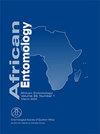南非外来入侵植物的天敌目录:考虑、释放和建立的经典生物防治剂、田间存在的外来天敌和生物除草剂
IF 1.2
4区 农林科学
Q3 ENTOMOLOGY
引用次数: 14
摘要
在南非,作为生物防治(生物防治)剂考虑并释放的天敌目录已保存多年,并在此更新,以包括2011-2020年期间。目前的目录对已被批准为经典生物防治剂的外来天敌的数据进行了重新排序和分离,从那些已被考虑但尚未释放的外来天敌,无意中与包括目标杂草物种在内的寄主植物一起引入南非的外来天敌,以及被认为是生物除草剂的本地来源的外来天敌。90种杂草已被确定为生物防治目标,其中310种为外来天敌,136种被列为法律上或事实上的经典生物防治剂,92种已在66种目标杂草上确定。研究人员发现,其中10个物种是在对它们进行研究时独立生存下来的。在目标杂草上发现了另外6种外来物种,并考虑了11种当地来源的天敌用于淹没或增强型生物防治,其中两种已被商业化开发。在故意建立的外来天敌中,35%对其寄主植物造成了广泛的破坏。昆虫占生物防治剂的大多数(90%),真菌占8%,螨占2%。不同分类群的建立率和损害程度各不相同。有五种以前被认为已经确定的生物防治剂,多年来一直没有在实地发现,它们的持久性值得怀疑。在植物种群水平上对54种目标杂草进行生物防治的结果表明,这些杂草已经建立了十多年的药剂。在过去十年中,由于持续的慷慨资助和有效的释放审批程序,所考虑的目标杂草数量以及释放的生物防治剂的数量都有所增加。本文章由计算机程序翻译,如有差异,请以英文原文为准。
A Catalogue of Natural Enemies of Invasive Alien Plants in South Africa: Classical Biological Control Agents Considered, Released and Established, Exotic Natural Enemies Present in the Field, and Bioherbicides
A catalogue of natural enemies considered and released as biological control (biocontrol) agents against invasive alien plants in South Africa has been maintained for many years, and is updated here to include the period 2011-2020. The current catalogue reorders and separates data for exotic natural enemies that have been approved as classical biocontrol agents, from those on exotic natural enemies that have been considered but not released, exotic natural enemies that have been inadvertently introduced into South Africa with host plants that include target weed species, and locally sourced natural enemies that have been considered as bioherbicides. Ninety weed species have been targeted for biocontrol, with 310 exotic natural enemies considered, 136 classified as de jure or de facto classical biocontrol agents, and 92 established in the field on 66 target weeds. Ten of these species were found to have established independently of being released while research on them was in progress. An additional six exotic species have been found established on target weeds, and 11 locally sourced natural enemies have been considered for inundative or augmentative biocontrol, of which two have been developed commercially. Of the exotic natural enemies deliberately established, 35% inflict extensive damage to their host plants. Insects make up the majority of biocontrol agents (90%), with the balance of 8% being fungi and 2%, mites. Both establishment rates and damage levels vary between taxa. Five biocontrol agents previously considered established, have not been found in the field for several years and their persistence is in doubt. Outcomes of biocontrol at a plant population level are indicated for 54 target weeds on which agents have been established for over a decade. The increase in numbers of target weeds considered, as well as biocontrol agents released, over the past decade, has been enabled by continued generous funding and an efficient release-approval process.
求助全文
通过发布文献求助,成功后即可免费获取论文全文。
去求助
来源期刊

African Entomology
生物-昆虫学
CiteScore
2.00
自引率
0.00%
发文量
17
审稿时长
6-12 weeks
期刊介绍:
African Entomology (ISSN 1021-3589 – print / 2224-8854 – online) replaced the old Journal of the Entomological Society of Southern Africa in 1993. A single volume consisting of two issues (March and September) is published annually. The journal is indexed in all major abstracting journals
African Entomology is a peer reviewed scientific journal that publishes original research articles and short communications on all aspects of entomology, with an emphasis on the advancement of entomology on the African continent.
 求助内容:
求助内容: 应助结果提醒方式:
应助结果提醒方式:


